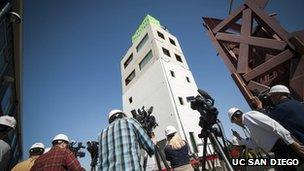Engineers launch artificial earthquakes at 'hospital'
- Published

The five-storey building is protected from earthquakes by rubber bearings
Engineers in California have unleashed high-intensity artificial earthquakes on a five-storey building packed with medical equipment.
The mock hospital has been built on a giant "shake table" which can subject the building to movements similar to real earthquakes.
The tests are designed to determine if hospitals built on rubber bearings could function after a quake.
The use of these rubber bearings is common in earthquake-prone Japan.
The $5m (£3.1m) project also tested whether the bearings could protect other strategically important buildings, such as computer data centres, so they could operate without interruption after a large earthquake.
It is the first time that the bearing system has been tested under a full-scale building on a shake table in the United States.
"What the bearings do is uncouple the building from the motion of the ground during an earthquake, like putting the building on roller skates," said Tara Hutchinson, an engineering professor at the University of California, San Diego.
She said that while most research concentrated on the structural integrity of buildings after an earthquake, very little examined how vital contents such as stairs, lifts and other parts of a building that allowed it to fulfil its function fared after a major seismic event.
Earthquakes replayed
The building was equipped with a surgery and an intensive-care unit, computer servers and other electrical equipment, as well as stairs and a working lift.
The 80ft (24m) structure was also clad in precast concrete and synthetic stucco, two materials which are commonly used in commercial construction projects, and a large water tower and a heating and air-conditioning system was installed on the roof.
On the first day of testing in early April, the shake table subjected the building to identical motions to those recorded during the 1994 Northridge earthquake in Los Angeles, which measured 6.7 on the Richter scale, and the 8.8-magnitude Chile earthquake in 2010.
The engineers found that the rubber bearings (or "base isolators") successfully protected the building from most of the damaging lateral motion that it would experience during a real earthquake. It also left lifts, stairs, medical equipment and other machinery intact, although there was some minor cosmetic damage.
"What we found is that the contents of the building carried on working after our 'earthquakes'," said Professor Hutchinson. "If the equipment had been life-support systems keeping real people alive, then the bearings would have saved their lives."
Engineers have now removed the base isolators from beneath the building, and over the next three weeks Professor Hutchinson will repeat the simulated earthquakes so that a direct comparison can be made between the damage to the building's contents with and without them in place.
Rubber base isolators have already been retrofitted under the Los Angeles, Oakland and San Francisco city halls.
- Published12 April 2012